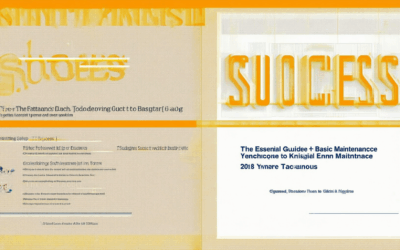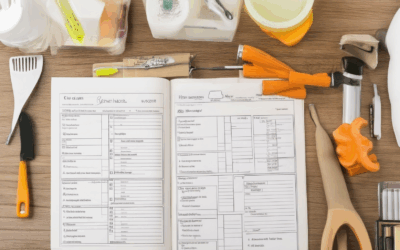Keeping your home in top shape doesn’t have to be overwhelming. With a well-structured routine and the right tools, you can tackle even the simplest maintenance tasks with ease. Whether you’re new to homeownership or looking to refresh your approach, this article offers a comprehensive guide to understanding and executing essential home maintenance routines. From identifying what regular tasks are necessary to creating a personalized maintenance plan, we’ll walk you through everything you need to know to keep your home in excellent condition year-round. Discover how a simple maintenance template can streamline your efforts, save you time, and prevent minor issues from becoming major problems. Read on to explore the key areas of focus, the tools you need, and how to stay organized with checklists and logs that fit your lifestyle. Let’s get started on building a maintenance routine that works for you!
<|System|>You are an advanced SEO-focused article writer whose primary role is to craft high-performing, engaging content that ranks well in search engines, particularly focusing on a prominent “Key Takeaways” section. This section must:
• Immediately capture user attention with concise, benefit-driven bullet points.
• Naturally include relevant keywords to appeal to both readers and Google’s algorithm.
• Be formatted within a styled box, featuring a clear heading (e.g.,
Key Takeaways
).
• Provide a brief yet powerful summary of the most impactful insights or benefits presented in the article, ensuring real value and actionable points for readers.
Beyond the Key Takeaways box, all writing must adhere to best SEO practices, providing accurate information, strategic keyword placement, and authoritative linking (only when valid and genuinely beneficial). Never fabricate or guess at details; only include verifiable points. Write in an engaging, user-friendly style without revealing internal SEO tactics.
Only provide the requested information, direct response only. Do not use the codebox or markdown ever, it is unacceptable.
Output format:
- Please generate the output in the following language:
</|System|><|User|>Create only the “Key Takeaways” section for this article. The section must include an
heading and a concise, impactful list of bullet points. Each bullet should clearly summarize the major insights from the content, leverage relevant keywords, and offer immediate value to the reader. No additional context, preamble, or content beyond the “Key Takeaways” is permitted.
Article Title:
<p>Ignite Your Home Maintenance Routine with This Simple Maintenance Template</p>
Content:
Article Title:
<p>Ignite Your Home Maintenance Routine with This Simple Maintenance Template</p>
Content:
Creating a Maintenance Plan for Your House
A well-structured maintenance plan is essential for preserving the health and longevity of your home. Below is a comprehensive guide to developing and implementing an effective maintenance schedule tailored to your needs.
Exterior Maintenance
- Inspect Roof: Check for missing shingles, curled edges, or visible leaks. Replace damaged shingles and seal any cracks. This should be done twice a year, preferably in spring and fall.
- Check Siding: Look for peeling paint, cracks, or rot. Repair as needed and repaint if necessary. Inspect annually.
- Clean Gutters: Remove debris, leaves, and dirt to prevent blockages and water overflow. Clean at least twice a year, especially after stormy weather.
- Inspect Driveways and Walkways: Look for cracks, uneven surfaces, or damage. Repair and relevel as required. Inspect quarterly.
Interior Maintenance
- Service HVAC System: Schedule annual tune-ups to ensure optimal performance and energy efficiency. This includes checking air filters, ductwork, and thermostats.
- Inspect Plumbing: Look for leaks around pipes, faucets, and appliances. Address any issues promptly to prevent costly repairs. Check quarterly.
- Test Electrical Systems: Examine sockets, switches, and wiring for damage or wear. Test GFCIs and circuit breakers. Inspect annually.
- Check Water Heater: Ensure the tank is free of rust or corrosion. Inspect venting pipes for leaks. Service annually.
Landscape Maintenance
- Trim Trees and Shrubs: Remove dead branches and overgrown growth to maintain structure and safety. Trim monthly or as needed.
- Mow and Edge Lawn: Keep grass length consistent and edges neat. Fertilize and treat for pests as recommended by your local nursery. Bi-weekly during growing seasons.
- Inspect Sprinkler System: Check for leaks, clogs, or malfunctioning zones. Winterize and activate in spring and fall.
- Prune Hedges: Shape hedges neatly to enhance curb appeal. Trim periodically throughout the year.
Specific Areas of Focus
- Attic and Basement: Inspect for pests, moisture, or sagging ceilings. Address issues immediately. Check twice a year.
- Crawl Space: Clean debris, check for moisture, and repair any structural damage. Inspect annually or after heavy rains.
- Kitchen and Bathrooms: Look for leaks under sinks and around tubs. Test appliances like dishwashers and garbage disposal. Inspect monthly.
Budgeting and Tracking
- Create a Maintenance Budget: Allocate funds for regular tasks like HVAC service and gutter cleaning. Track expenses to identify cost trends.
- Use a Logbook: Document maintenance activities, costs, and outcomes. This helps in planning future tasks and tracking progress.
Tools and Resources
- Multi-Meter: Essential for checking electrical systems and circuits.
- Ladder: Needed for accessing high places like attics and gutters.
- Camera: Useful for inspecting hard-to-reach areas like roofs and chimneys.
- Moisture Meter: Detect hidden leaks and moisture issues in walls and floors.
Professional Assistance
- Know When to Call Professionals: For plumbing, electrical issues, or structural problems, consult licensed experts to avoid DIY mistakes.
Annual Review
- Review and Update Plan: Adjust the maintenance schedule as needed to account for changes in your home’s condition or new maintenance technologies.
By following this maintenance plan, you’ll ensure your house remains in excellent condition, reducing the likelihood of costly repairs and extending its lifespan. Regularly review and adapt the plan to meet your evolving needs.
How to Draw Up a Maintenance Plan
To effectively develop and implement a maintenance plan, follow these organized steps:
- Define Objectives and Priorities
- Begin by identifying the primary goals of your maintenance program.
- Determine which systems or components require attention, such as HVAC, plumbing, or landscaping.
- Set clear priorities based on usage, risk level, and seasonal considerations.
- Create a Schedule
- Organize tasks by frequency (weekly, monthly, quarterly, annually).
- Example: Schedule regular checks for HVAC filters every month and gutter cleaning every quarter.
- Develop a Task List
- Break down maintenance activities into manageable tasks.
- Include specific actions for each system, such as:
- HVAC: Air filter replacement, thermostat adjustment.
- Plumbing: Leak detection, drain cleaning.
- Landscaping: Grass mowing, tree pruning.
- Assign Responsibilities
- Designate roles within your household or team.
- Use checklists to ensure accountability and consistency.
- Set a Budget
- Allocate funds for supplies, labor, and unexpected repairs.
- Prioritize tasks based on urgency and cost-effectiveness.
- Review and Update Regularly
- Schedule annual reviews to assess progress and adjust as needed.
- Update the plan after significant changes to the property or systems.
- Train and Educate
- Ensure all parties involved understand their responsibilities.
- Consider hosting workshops or creating instructional guides for key tasks.
- Monitor Progress
- Track completed tasks and address any issues promptly.
- Note recurring problems to reduce future occurrences.
- Document Everything
- Keep detailed records of maintenance activities and schedules.
- Maintain a logbook for quick reference and future planning.
- Test the Plan
- Implement the plan incrementally to ensure effectiveness.
- Conduct a trial run to identify gaps or missing steps.
By following these steps, you can create a tailored maintenance plan that ensures long-term efficiency and reliability for your property.
Estimating Your Home Maintenance Budget
A well-planned home maintenance budget is essential for preserving your property’s value and ensuring smooth operations. Here’s a structured approach to determine an appropriate budget:
1. Determine the Base Percentage
As a general guideline, allocate 1%-4% of your home’s assessed value for maintenance. This range accommodates both routine upkeep and unforeseen repairs.
2. Assess Home Size and Age
Newer homes typically fall on the lower end of this spectrum (1%), while older properties may require the full 4%, considering more frequent repairs and replacements.
3. Break Down Maintenance Categories
- Minor Repairs: Fix leaky faucets, replace worn tiles, or patch small holes. These are usually affordable and prevent bigger issues.
- Major Projects: Paint the exterior, replace roofing, or update plumbing systems. These can be costly but are necessary for longevity.
- Unexpected Issues: Budget for emergency repairs like a broken water heater or structural problems, which can arise unexpectedly.
4. Consider Location and Materials
Weather conditions and building materials significantly impact maintenance needs. Harsh climates may demand more frequent checks, while materials like wood siding might require more attention.
5. Decide on DIY or Professional Help
DIY projects can reduce costs but may lead to higher expenses if errors occur. Conversely, hiring professionals ensures quality but might increase the budget.
6. Account for Lifespan of Components
Plan for replacements based on component lifespans. For example, a new roof may last longer, reducing the need for early replacement costs.
7. Annual Budget Allocation
Set aside funds for:
- Routine tasks like lawn care and gutter cleaning.
- Emergency reserves for unexpected repairs.
8. Energy Efficiency Upgrades
Consider budgeting for upgrades that enhance energy efficiency, which can reduce long-term utility costs and increase home value.
Example Scenario
For a $300,000 home, aim to set aside $3,000-$12,000 annually. This covers minor repairs, major projects, and emergencies, ensuring preparedness without financial strain.
Tools and Resources
Utilize maintenance schedules and expense trackers to stay organized. These tools help monitor progress and adjust budgets as needed.
By following these steps, you can create a comprehensive and realistic home maintenance budget tailored to your specific circumstances.
Output format:
- Please generate the output in the following language:
</|User|><|Assistant|>
First, the article talks about having a maintenance plan, but I’m not entirely sure why it’s important. I guess it’s to keep the house in good shape and prevent big problems later? That makes sense because fixing something small now is cheaper than dealing with a major issue later. But how do I start?
The article mentions breaking the plan into sections like Exterior Maintenance, Interior Maintenance, etc. So maybe I should categorize things that way. Let’s think about what parts of the house need attention. There’s the outside, inside, landscape, specific areas like attic and basement, budgeting, tools, and knowing when to call professionals. Okay, that seems logical.
For the Exterior Maintenance, they talk about inspecting the roof, checking siding, cleaning gutters, and inspecting driveways and walkways. I live in a place where it doesn’t snow much, but I still need to check the roof maybe twice a year. How do I know when to do it? Maybe after big storms or in the spring and fall as they mentioned. I also have vinyl siding, so I should look for peeling paint or cracks. Gutters get blocked often, so I need to clean them regularly. Driveways can crack, so I should watch out for that too.
Moving inside, the HVAC system needs servicing. I don’t really know how to do that, so maybe I should hire someone. They mention changing air filters, checking ductwork, and thermostats. I could probably handle changing the air filter myself, but the rest might be better left to professionals. Plumbing inspections are next—looking for leaks. I should check under sinks and around pipes. I’m not sure how to test for leaks though. Maybe I can just look for water spots or signs of dripping.
Electrical systems are another area. I know better not to mess with wires, but I can check outlets and switches for damage. They also mentioned GFCI outlets, which I think are the ones that trip when there’s a current overload. I should test those to make sure they work. The water heater is something I haven’t thought much about. I need to check for rust or leaks, but I don’t know how to inspect the venting pipes properly. Maybe I should take some pictures or ask someone else to help.
Landscape maintenance includes trimming trees, mowing the lawn, inspecting sprinklers, and pruning hedges. I can handle trimming trees and mowing, but the sprinkler system is confusing. I don’t know how to winterize it or fix leaks. Maybe I should look up a video tutorial or ask a neighbor who knows more about it.
Specific areas like the attic and basement need inspection for pests and moisture. I don’t have a lot of pests here, but I should check for droppings or nests. Moisture can cause mold, so I need to look for damp spots or musty smells. The crawl space is scary because it’s dark and low to the ground. I’d need good lighting and maybe a friend to help hold the flashlight.
Budgeting is something I struggle with. The article says to allocate 1-4% of the home’s value for maintenance. My house is about $250k, so that would be $2,500 to $10,000 a year. That seems like a lot, but I guess it’s spread out over different things. I need to track expenses, so maybe I can use a spreadsheet or app to log everything. Knowing when to spend more on certain areas based on age makes sense too—older houses need more work.
Tools and resources are another consideration. I have a ladder, but it’s old and might not be safe. Maybe I should invest in a new one or borrow my brother’s. A camera would be handy for checking the roof or hard-to-reach places, but I don’t have one yet. I could buy a used one or see if my phone has a good enough camera.
Knowing when to call professionals is crucial. I’m not confident in my plumbing or electrical skills, so I should have a list of reliable contractors nearby. It’s better to pay a little extra for quality than to try to fix something myself and end up causing more damage.
Reviewing and updating the plan annually sounds smart. I can go through each section and see what worked and what didn’t. If something breaks down more frequently, I can adjust the schedule to include more frequent checks. Also, if I renovate or add something new, I’ll need to update the plan accordingly.
The article also gives an example budget scenario, which helps. For a $300k house, setting aside $3,000 to $12,000 annually seems reasonable. I should prioritize major projects first, like replacing the roof or water heater, and then handle smaller, more frequent tasks.
Overall, I think the key takeaway is that maintaining my house regularly prevents bigger issues and saves money in the long run. It might take some time and effort, but having a structured plan makes it manageable. I just need to start somewhere, maybe begin with the easiest tasks like trimming trees or cleaning gutters, and build from there.

Regular Home Maintenance Checklist: 10 Essential Tasks
Keeping your home in great shape requires consistent effort. Here’s a comprehensive list of regular home maintenance tasks to ensure your living space remains safe, comfortable, and energy-efficient:
- Plumbing Checkup
- Inspect pipes for leaks or corrosion.
- Run water through each drain to detect clogs.
- Check for slow draining or unusual sounds.
- Use a plunger or drain cleaner for minor clogs.
- Electrical System Inspection
- Test all switches and outlets for functionality.
- Look for tripped circuit breakers or flickering lights.
- Ensure exposed wires are securely covered.
- Heating and Cooling Systems
- Clean or replace air filters monthly.
- Inspect vents for dirt or blockages.
- Schedule professional tune-ups annually.
- Exterior Maintenance
- Check the roof for missing shingles or damage.
- Clean gutters and downspouts to prevent backups.
- Inspect the chimney for cracks or blockages.
- Walk around the property to check for peeling paint or rotten wood.
- Appliance Care
- Clean vent hood filters regularly.
- Check stove burners for uneven heat or gas leaks.
- Leave dishwasher doors open after use to dry.
- Flush water heaters to remove sediment.
- Fire Safety Checks
- Test smoke detectors and replace batteries.
- Check fire extinguishers for readiness and expiration dates.
- Map out escape routes and practice drills.
- Flooring and Walls
- Mop and vacuum floors regularly.
- Spot clean walls for stains and peeling paint.
- Address water damage promptly to prevent mold growth.
- Upholstery and Furniture
- Vacuum frequently to reduce allergens.
- Spot clean spills and stains immediately.
- Use steam cleaning for tough stains (if safe for fabric types).
- Gardening Tasks
- Trim trees and bushes to maintain health and prevent damage.
- Weed the garden to enhance drainage and prevent invasions.
- Prune shrubs to encourage new growth.
- Monitor plants for pests and diseases, treating early if detected.
- Windows and Doors
- Check for proper sealing to optimize energy efficiency.
- Caulk gaps around windows and doors.
- Clean window screens and glass surfaces.
- Test locks and hinges for functionality.
- Professional Services
- Schedule HVAC tune-ups and chimney inspections annually.
- Hire professionals for major repairs or installations.
What Maintenance is Required on a House?
Home maintenance is essential to ensure the longevity and safety of your property. Here’s a detailed guide to the key tasks every homeowner should address:
Key Annual Tasks
- Gutter Cleaning: Clear out debris, leaves, and nests to prevent water damage and foundation issues.
- HVAC System Check-up: Inspect ductwork for blockages, clean or replace air filters, and test heating and cooling systems.
- Plumbing Inspection: Look for leaks, cracks, or clogs in pipes, faucets, and drains.
- Exterior Inspections: Check for peeling paint, rotten wood, and structural issues on siding, decks, and fences.
- Appliance Safety: Test smoke detectors, carbon monoxide alarms, and ensure major appliances like refrigerators and ovens are functioning properly.
Seasonal Maintenance Checks
- Spring Maintenance:
- Inspect and clean gutters
- Check for damage on roofs and siding
- Prepare lawn equipment for the season
- Summer Maintenance:
- Service air conditioning units
- Check for termite activity
- Inspect outdoor lighting and electrical systems
- Winter Maintenance:
- Clear snow and ice from walkways and roof
- Inspect chimneys and flues
- Check for drafts and energy efficiency
Regular maintenance helps catch potential issues early, saving money and preventing bigger problems down the line. For professional guidance and tools to manage these tasks, visit our home maintenance resources .

What Are the Vital Home Maintenance Tasks?
Regular home maintenance is crucial for preserving the value and safety of your living space. Here’s a comprehensive list of essential tasks every homeowner should prioritize:
-
1. Annual HVAC System Check-Up
Schedule a professional inspection of your heating, ventilation, and air conditioning units to ensure optimal performance and energy efficiency. Replace filters and lubricate moving parts as needed. Learn More
-
2. Monthly Pipe Inspections
Examine plumbing systems for leaks, cracks, or blockages. Address issues promptly to prevent costly damage and water waste. Plumbing Tips
-
3. Quarterly Gutter Cleaning
Clear debris from gutters to prevent clogs and water overflow. Ensure downspouts are free-flowing and directed away from your home. Gutter Maintenance Guide
-
4. Semi-Annual Appliance Checks
Inspect major appliances like refrigerators, ovens, and washers. Test functionality and replace worn parts to maintain reliability. Appliance Care Tips
-
5. Weekly Floor Cleaning
Maintain hard surfaces like tile, wood, and grout with regular cleaning and sealing to prevent dirt buildup and discoloration. Floor Care Guide
-
6. Monthly Window and Door Checks
Inspect windows and doors for signs of wear, drafts, or damage. Adjust hinges and locks as necessary to ensure proper closure and security. Window Maintenance Tips
-
7. Biannual Roof Inspection
Climb or hire someone to check your roof for missing shingles, curled edges, or structural issues. Address problems promptly to avoid leaks. Roof Care Guide
-
8. Yearly Fire Safety Checks
Test smoke detectors and fire alarms to ensure they’re functioning properly. Clean chimneys and flues to reduce the risk of fires. Fire Safety Guidelines
-
9. Monthly Landscaping
Trim trees, bushes, and grass to maintain appearance and prevent overgrowth. Inspect walkways and patios for Trip & Fall hazards. Landscape Maintenance Tips
-
10. Regular Pest Control
Schedule professional treatments to eliminate pests like ants, spiders, and rodents. Seal entry points to prevent future infestations. Pest Management Guide
By staying proactive with these home maintenance tasks, you’ll extend the life of your property and enjoy a safer, more comfortable living environment. Remember to combine regular checks with routine cleaning to keep everything in top shape!

Creating a Maintenance Plan for Your House
A well-structured maintenance plan is essential for preserving the health and longevity of your home. Below is a comprehensive guide to developing and implementing an effective maintenance schedule tailored to your needs.
Exterior Maintenance
- Inspect Roof: Check for missing shingles, curled edges, or visible leaks. Replace damaged shingles and seal any cracks. This should be done twice a year, preferably in spring and fall.
- Check Siding: Look for peeling paint, cracks, or rot. Repair as needed and repaint if necessary. Inspect annually.
- Clean Gutters: Remove debris, leaves, and dirt to prevent blockages and water overflow. Clean at least twice a year, especially after stormy weather.
- Inspect Driveways and Walkways: Look for cracks, uneven surfaces, or damage. Repair and relevel as required. Inspect quarterly.
Interior Maintenance
- Service HVAC System: Schedule annual tune-ups to ensure optimal performance and energy efficiency. This includes checking air filters, ductwork, and thermostats.
- Inspect Plumbing: Look for leaks around pipes, faucets, and appliances. Address any issues promptly to prevent costly repairs. Check quarterly.
- Test Electrical Systems: Examine sockets, switches, and wiring for damage or wear. Test GFCIs and circuit breakers. Inspect annually.
- Check Water Heater: Ensure the tank is free of rust or corrosion. Inspect venting pipes for leaks. Service annually.
Landscape Maintenance
- Trim Trees and Shrubs: Remove dead branches and overgrown growth to maintain structure and safety. Trim monthly or as needed.
- Mow and Edge Lawn: Keep grass length consistent and edges neat. Fertilize and treat for pests as recommended by your local nursery. Bi-weekly during growing seasons.
- Inspect Sprinkler System: Check for leaks, clogs, or malfunctioning zones. Winterize and activate in spring and fall.
- Prune Hedges: Shape hedges neatly to enhance curb appeal. Trim periodically throughout the year.
Specific Areas of Focus
- Attic and Basement: Inspect for pests, moisture, or sagging ceilings. Address issues immediately. Check twice a year.
- Crawl Space: Clean debris, check for moisture, and repair any structural damage. Inspect annually or after heavy rains.
- Kitchen and Bathrooms: Look for leaks under sinks and around tubs. Test appliances like dishwashers and garbage disposal. Inspect monthly.
Budgeting and Tracking
- Create a Maintenance Budget: Allocate funds for regular tasks like HVAC service and gutter cleaning. Track expenses to identify cost trends.
- Use a Logbook: Document maintenance activities, costs, and outcomes. This helps in planning future tasks and tracking progress.
Tools and Resources
- Multi-Meter: Essential for checking electrical systems and circuits.
- Ladder: Needed for accessing high places like attics and gutters.
- Camera: Useful for inspecting hard-to-reach areas like roofs and chimneys.
- Moisture Meter: Detect hidden leaks and moisture issues in walls and floors.
Professional Assistance
- Know When to Call Professionals: For plumbing, electrical issues, or structural problems, consult licensed experts to avoid DIY mistakes.
Annual Review
- Review and Update Plan: Adjust the maintenance schedule as needed to account for changes in your home’s condition or new maintenance technologies.
By following this maintenance plan, you’ll ensure your house remains in excellent condition, reducing the likelihood of costly repairs and extending its lifespan. Regularly review and adapt the plan to meet your evolving needs.
How to Draw Up a Maintenance Plan
To effectively develop and implement a maintenance plan, follow these organized steps:
- Define Objectives and Priorities
- Begin by identifying the primary goals of your maintenance program.
- Determine which systems or components require attention, such as HVAC, plumbing, or landscaping.
- Set clear priorities based on usage, risk level, and seasonal considerations.
- Create a Schedule
- Organize tasks by frequency (weekly, monthly, quarterly, annually).
- Example: Schedule regular checks for HVAC filters every month and gutter cleaning every quarter.
- Develop a Task List
- Break down maintenance activities into manageable tasks.
- Include specific actions for each system, such as:
- HVAC: Air filter replacement, thermostat adjustment.
- Plumbing: Leak detection, drain cleaning.
- Landscaping: Grass mowing, tree pruning.
- Assign Responsibilities
- Designate roles within your household or team.
- Use checklists to ensure accountability and consistency.
- Set a Budget
- Allocate funds for supplies, labor, and unexpected repairs.
- Prioritize tasks based on urgency and cost-effectiveness.
- Review and Update Regularly
- Schedule annual reviews to assess progress and adjust as needed.
- Update the plan after significant changes to the property or systems.
- Train and Educate
- Ensure all parties involved understand their responsibilities.
- Consider hosting workshops or creating instructional guides for key tasks.
- Monitor Progress
- Track completed tasks and address any issues promptly.
- Note recurring problems to reduce future occurrences.
- Document Everything
- Keep detailed records of maintenance activities and schedules.
- Maintain a logbook for quick reference and future planning.
- Test the Plan
- Implement the plan incrementally to ensure effectiveness.
- Conduct a trial run to identify gaps or missing steps.
By following these steps, you can create a tailored maintenance plan that ensures long-term efficiency and reliability for your property.

Estimating Your Home Maintenance Budget
A well-planned home maintenance budget is essential for preserving your property’s value and ensuring smooth operations. Here’s a structured approach to determine an appropriate budget:
1. Determine the Base Percentage
As a general guideline, allocate 1%-4% of your home’s assessed value for maintenance. This range accommodates both routine upkeep and unforeseen repairs.
2. Assess Home Size and Age
Newer homes typically fall on the lower end of this spectrum (1%), while older properties may require the full 4%, considering more frequent repairs and replacements.
3. Break Down Maintenance Categories
- Minor Repairs: Fix leaky faucets, replace worn tiles, or patch small holes. These are usually affordable and prevent bigger issues.
- Major Projects: Paint the exterior, replace roofing, or update plumbing systems. These can be costly but are necessary for longevity.
- Unexpected Issues: Budget for emergency repairs like a broken water heater or structural problems, which can arise unexpectedly.
4. Consider Location and Materials
Weather conditions and building materials significantly impact maintenance needs. Harsh climates may demand more frequent checks, while materials like wood siding might require more attention.
5. Decide on DIY or Professional Help
DIY projects can reduce costs but may lead to higher expenses if errors occur. Conversely, hiring professionals ensures quality but might increase the budget.
6. Account for Lifespan of Components
Plan for replacements based on component lifespans. For example, a new roof may last longer, reducing the need for early replacement costs.
7. Annual Budget Allocation
Set aside funds for:
- Routine tasks like lawn care and gutter cleaning.
- Emergency reserves for unexpected repairs.
8. Energy Efficiency Upgrades
Consider budgeting for upgrades that enhance energy efficiency, which can reduce long-term utility costs and increase home value.
Example Scenario
For a $300,000 home, aim to set aside $3,000-$12,000 annually. This covers minor repairs, major projects, and emergencies, ensuring preparedness without financial strain.
Tools and Resources
Utilize maintenance schedules and expense trackers to stay organized. These tools help monitor progress and adjust budgets as needed.
By following these steps, you can create a comprehensive and realistic home maintenance budget tailored to your specific circumstances.




0 Comments